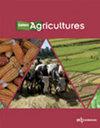干旱季节补灌对墨西哥塔巴斯科油棕植株蒸腾和生殖发育的影响
IF 1.1
4区 农林科学
Q3 AGRICULTURE, MULTIDISCIPLINARY
引用次数: 0
摘要
一些油棕产区有降雨少的时期,引起缺水,影响产量。本研究的目的是评价旱季补灌对油棕树水分利用和蒸腾的影响,以及对不同物候阶段油棕树形态变化的影响。监测地点为墨西哥塔巴斯科省Jalapa的一个油棕种植园(17°38 N;92°56 w;海拔20米)。在那里,植物密度为143棕榈ha−1。两处棕榈树的树龄分别为6年和11年。土壤类型为Gleysol。一个气象站被安置在一个牧场附近(1公里)的种植园。2017年4月1日至6月23日,采用BBCH尺度对人工林的结构特征、液流、蒸腾和不同物候阶段的形态变化进行评价。结果表明,不同树龄棕榈树的单株耗水量(102 ~ 140 kg day−1)和蒸腾量(1.59 ~ 2.11 mm day−1)差异不显著。在旱季灌溉维持了两个年龄的棕榈的蒸腾作用,并通过缩短棕榈植株达到果实形成阶段(503-700期)的天数来促进花序发育和果实形成,但增加了棕榈植株达到成熟阶段(709期至收获)所需的天数。这项研究在几个月内进行,需要通过更长期的监测来证实。本文章由计算机程序翻译,如有差异,请以英文原文为准。
Effect of supplementary irrigation on the transpiration and reproductive development of oil palm trees during the dry season in Tabasco, Mexico
Some oil palm production zones have periods of low rainfall, eliciting to water stress and impacting yields. The objective of this study was to evaluate the effect of the supplementary irrigation application during the dry season, on the water use and the transpiration of oil palm trees, and on morphological changes that occur during the different phenological stages. The monitored site was an oil palm plantation in Jalapa, Tabasco, Mexico (17° 38 N; 92° 56 W; altitude 20 m). There, the plant density is 143 palms ha−1. Two areas of palm trees with ages of 6 and 11 years were located. The soil type was classified as Gleysol. A weather station was placed in a pasture adjacent (1 km) to the plantation. The variables, evaluated from April 1 to June 23, 2017, included the structural characteristics of the plantation, sap flow, transpiration, and the morphological changes at the different phenological stages, which were assessed based on the BBCH scale. The results showed that the water use per palm tree (102–140 kg day−1) and the transpiration (1.59–2.11 mm day−1) were not significantly different among palm trees ages. The application of irrigation during the dry season maintained transpiration in palms of both ages and favoured inflorescence development and fruit formation by shortening the number of days it took the palm plants to reach fruit formation stage (stages 503-700), but increased the number of days required by the bunches to reach maturation (stages 709 to harvest). This study conducted during few months needs to be confirmed by longer term monitoring.
求助全文
通过发布文献求助,成功后即可免费获取论文全文。
去求助
来源期刊

Cahiers Agricultures
农林科学-农业综合
CiteScore
2.00
自引率
22.20%
发文量
23
审稿时长
3 months
期刊介绍:
Cahiers Agricultures is a - mainly - French language scientific journal on world farming systems, how they are changing and their role in society. It is aimed at all those – researchers, field workers, teachers – who are interested in a holistic reflection on the agricultural world.
Cahiers Agricultures gives priority to research on agriculture as implemented by farmers, that has meaning for citizens in countries in the North and South, as opposed to research work conducted in a controlled environment (laboratory, research center, etc.). Research of this type is often multidisciplinary and takes into account the knowledge and know-how of the different stakeholders. The different parties are also actively involved in research, alongside the scientists. In this way, the journal stimulates debate on issues linked to society, such as the impact of using water and nitrogen fertilisers, peri-urban farming, fish farming, livestock production in rural areas, food security, etc.
 求助内容:
求助内容: 应助结果提醒方式:
应助结果提醒方式:


